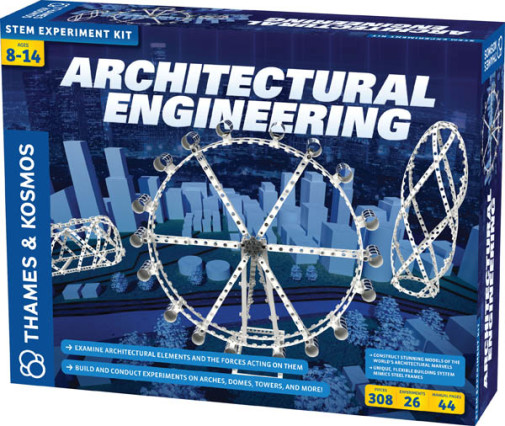We use cookies to make your experience better. To comply with the new e-Privacy directive, we need to ask for your consent to set the cookies. Learn more.
Architectural Engineering (STEM Experiment Kit)
Build - and test - some of the most recognizable architectural structures in the world while learning about elements like arches, domes, shells and trusses. This kit includes 308 pieces and a 44-page instructional manual with 26 projects 20 of which are models of famous structures. It's amazing that so many shapes and structures can be built with the pieces, which look deceptively simple! Based on steel frame design, the building components are made of both rods and connectors, some of which are flexible to allow for curves and domes. The manual starts off simply by introducing the components and asking builders to construct and build simple shapes, then graduates to building models of the Eiffel Tower, the Sydney Opera House, a Ferris wheel, a stadium and more. Some design challenges are also included, such as designing the tallest tower or the longest bridge.
Soaring spires, towering arches, fascinatingly complex curves and angles! Build your foundation in architectural design with this fascinating STEM experiment kit that explores the engineering principles behind planning and developing buildings and structures. Through model building exercises you play the role of architect and engineer as you piece together an array of models, from small, basic structural elements like trusses, arches, and domes, to giant complex models of real-world buildings. Try building the Sydney Opera House, or put the Eiffel Tower on display in your living room! With 20 guided model builds, you can construct stadiums, skyscrapers, a ferris wheel, and more.
By getting hands-on with these exercises, youll develop an understanding of how architectural engineers apply scientific principles to their designs and how the buildings and structures of the 21st century push materials and engineering to the limits. The 44-page, full-color manual guides your journey while encouraging independent exploration. What is the tallest tower, the most voluminous dome, or the longest bridge you can build with the modular building pieces? How will you use what you learn to further your architectural journey?
| Product Format: | Other |
|---|---|
| Brand: | Thames and Kosmos |
| Grades: | 3-9 |
| EAN/UPC: | 814743014138 |
| Length in Inches: | 11.625 |
| Width in Inches: | 14.5 |
| Height in Inches: | 3.125 |
| Weight in Pounds: | 2.2 |

